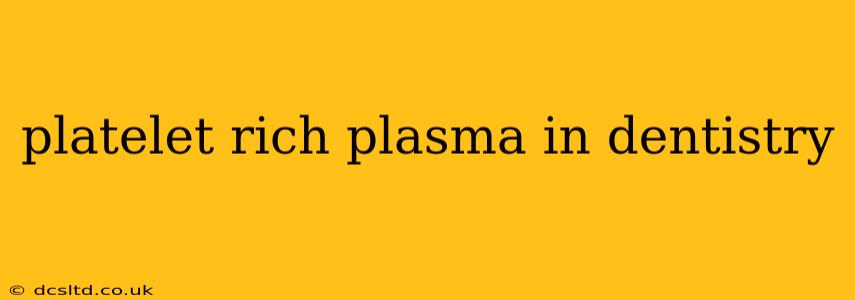Platelet-Rich Plasma (PRP) therapy has emerged as a promising advancement in dentistry, offering potential benefits for various procedures. This comprehensive guide explores the applications, benefits, and considerations of PRP in dental treatments. We'll delve into the science behind it, address common questions, and outline what you can expect from this innovative approach to oral health.
What is Platelet-Rich Plasma (PRP)?
PRP is a concentration of autologous (your own) platelets in a small volume of plasma. Platelets are blood cells crucial for blood clotting; however, they also contain numerous growth factors. These growth factors stimulate tissue regeneration and healing. In dentistry, PRP is harvested from a small blood sample taken from the patient, processed to concentrate the platelets, and then injected into the treatment area.
How is PRP Used in Dentistry?
PRP finds application in a variety of dental procedures, enhancing healing and promoting tissue regeneration. Some key applications include:
- Socket Preservation: After tooth extraction, PRP can be used to fill the socket, stimulating bone and tissue regeneration, reducing bone loss, and potentially improving the outcome of future implant placement.
- Guided Bone Regeneration (GBR): In cases of bone loss, PRP can be combined with bone grafting materials to enhance bone regeneration and facilitate successful implant placement.
- Sinus Augmentation: This procedure often involves lifting the sinus membrane to create space for bone grafting. PRP can be incorporated to accelerate bone formation and improve the overall outcome.
- Periodontal Regeneration: PRP can be used in conjunction with periodontal procedures to improve the regeneration of gum tissue and bone around teeth affected by periodontal disease.
- Treatment of Oral Ulcers and Wounds: PRP can accelerate the healing process of oral ulcers and wounds, reducing discomfort and healing time.
- Improving the success rate of dental implants: PRP can be used in conjunction with dental implant placement to stimulate bone growth around the implant, increasing its stability and longevity.
What are the Benefits of PRP in Dentistry?
The use of PRP in dentistry offers several potential benefits:
- Faster Healing: Growth factors in PRP accelerate tissue repair and reduce healing time compared to traditional methods.
- Reduced Inflammation: PRP can help reduce inflammation and promote a more comfortable recovery.
- Improved Aesthetic Outcomes: In procedures like gum regeneration, PRP can contribute to improved aesthetics by promoting the growth of healthy gum tissue.
- Enhanced Bone Regeneration: PRP stimulates bone growth, which is essential for successful implant placement and the treatment of periodontal disease.
- Reduced Post-operative Pain: Some patients experience reduced post-operative pain and discomfort.
What are the Risks and Side Effects of PRP?
While generally considered safe, PRP therapy carries some potential risks and side effects, including:
- Bleeding at the injection site: This is usually minimal and easily controlled.
- Infection: The risk of infection is low, especially with proper sterilization techniques.
- Pain or discomfort at the injection site: This is usually temporary and can be managed with pain relievers.
- Nerve damage (rare): Improper injection technique can, in rare cases, lead to nerve damage. Choosing a qualified and experienced dentist is vital to minimize this risk.
Is PRP Treatment Painful?
The procedure itself usually involves minimal discomfort. A local anesthetic is typically administered to numb the treatment area. Some patients report mild discomfort or pressure during the injection. Post-procedure discomfort is usually mild and can be managed with over-the-counter pain relievers.
How Long Does PRP Treatment Take?
The duration of PRP treatment varies depending on the specific procedure. The blood draw and PRP preparation usually take about 30-45 minutes. The actual injection time is relatively short.
How Much Does PRP Treatment Cost?
The cost of PRP treatment can vary depending on several factors, including the specific procedure, the dentist's fees, and geographic location. It is best to consult your dentist for an accurate cost estimate.
Is PRP Covered by Insurance?
Insurance coverage for PRP therapy varies greatly depending on the insurance provider and the specific procedure. Some insurance plans may cover PRP when used in conjunction with other covered procedures, while others may not provide any coverage. It's crucial to check with your insurance provider before undergoing treatment.
How Long Does it Take to See Results from PRP Treatment?
The time it takes to see results from PRP treatment varies depending on the specific procedure and the individual patient. Visible improvement may be noticeable within a few weeks to several months.
Conclusion
Platelet-Rich Plasma therapy represents a significant advancement in dental procedures, offering the potential for accelerated healing, improved tissue regeneration, and enhanced aesthetic outcomes. While not suitable for every patient, it offers a valuable tool for dentists to improve treatment success and patient experience. As always, consult with your dentist to determine if PRP therapy is the right option for your specific dental needs. They can assess your individual case and advise you on the potential benefits and risks associated with this treatment.
